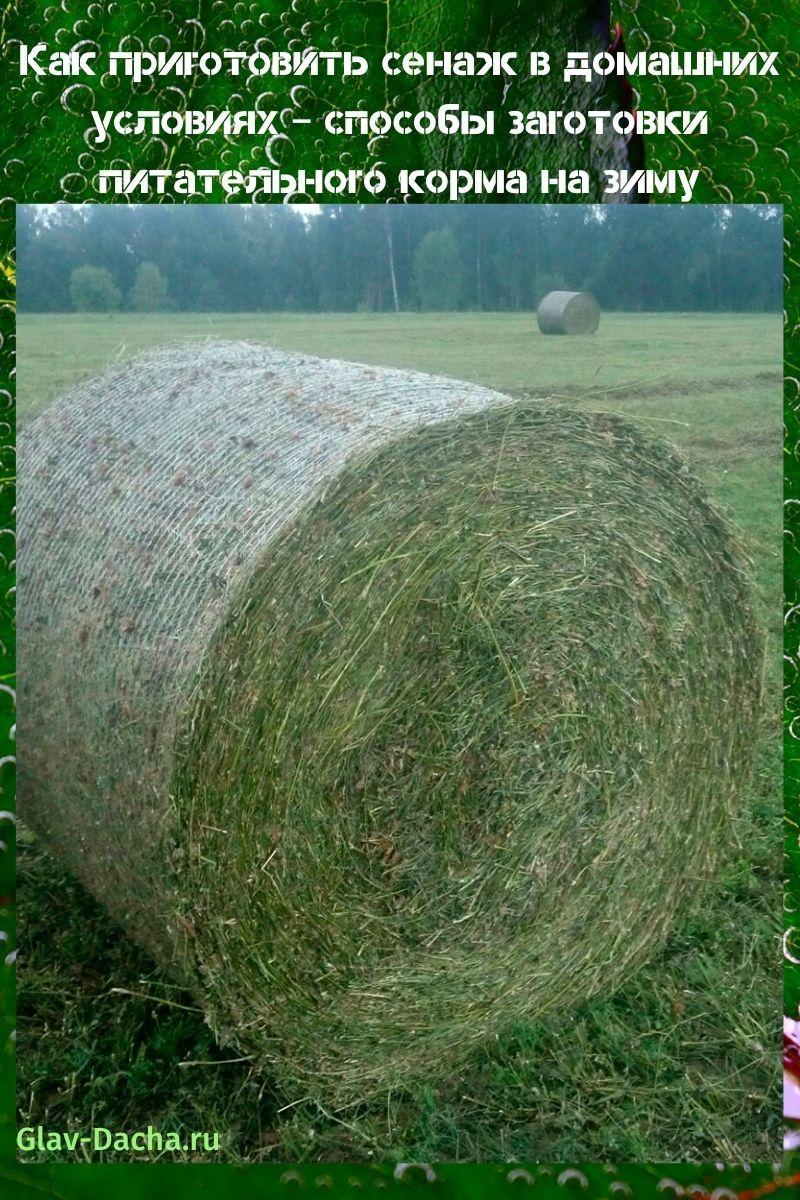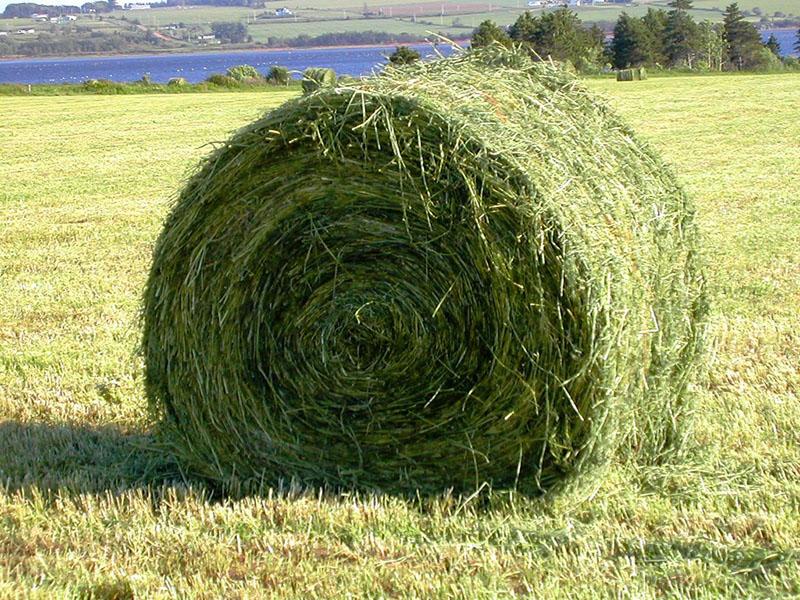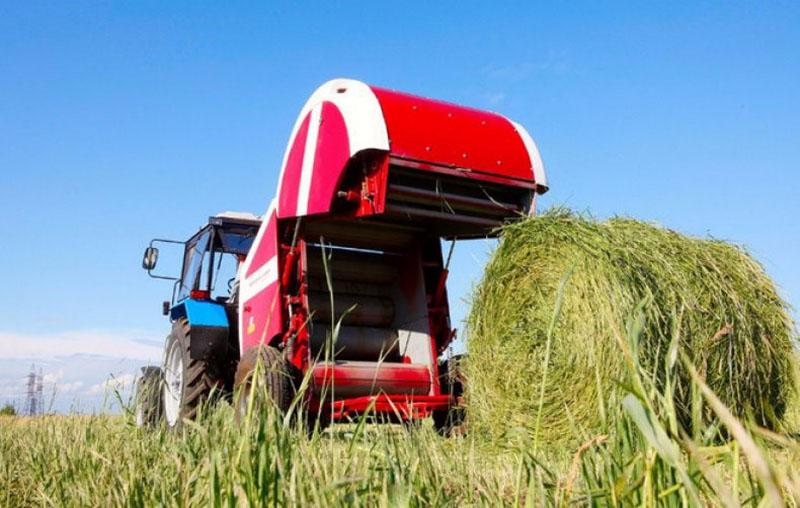How to make haylage at home - ways to prepare nutritious food for the winter
 Haylage is a special canned food for farm animals obtained from herbaceous thin-stemmed plants harvested at an early stage of the growing season. Knowing how to make haylage at home, every farmer will be able to prepare an effective forage base for cattle, allowing animals to easily survive the long winter season.
Haylage is a special canned food for farm animals obtained from herbaceous thin-stemmed plants harvested at an early stage of the growing season. Knowing how to make haylage at home, every farmer will be able to prepare an effective forage base for cattle, allowing animals to easily survive the long winter season.
What is haylage

The moisture content of the silage should be in the range of 50-55%, anaerobic storage conditions and physiological dryness of the green mass are used as a preservative factor. Due to this indicator of humidity, the vital activity of pathogenic microorganisms slows down.
One of the features that distinguishes haylage from silage is the reduced activity of lactic acid bacteria, due to anaerobic conditions. As a result, a minimum amount of organic acids is formed in the haylage and a high sugar level is maintained. At the same time, the pH acidity index, depending on the type of herbaceous plants, does not exceed 4.5-5.5 units. This ensures a high nutritional value of haylage and a significantly better absorption of nutrients than when feeding with silage.
Herbs used
 Before making haylage at home, you need to know what herbs are used for this.
Before making haylage at home, you need to know what herbs are used for this.
Recommended plants:
- clover;

- alfalfa;

- sainfoin;

- cereal-legume mixtures.

For haylage, you can use legumes, as well as their various mixtures with cereals. Legumes contain about 2 times more easily digestible carotene and proteins.
To obtain a highly nutritious forage, it is necessary to timely mow herbs - legumes during budding, cereals at the initial stage of spikelet formation. At the beginning of the flowering stage, harvesting ends.
It is very important not to miss the optimal time for harvesting herbs for haylage. When the stand reaches a height of 25-30 cm, its lodging begins, which greatly complicates mowing. In addition, after 8-10 days from the beginning of budding or heading, plants begin to bloom. The herbs can then only be used for making hay.
The main advantages of silage over silage

Before preparing haylage, it is necessary to take into account the main features of this type of feed and its advantages over silage:
- The minimum loss of nutrients does not exceed 10%. This maintains a high level of sugars and carotene.
- Moisture levels up to 55% ensure good palatability, which contributes to increased milk production.
- The haylage is made from alfalfa and legumes, which ensures that it is balanced in terms of protein and energy.
- Due to the minimum moisture level, the haylage is perfectly stored for a long time, does not get wet or freeze.
- The feed is harvested without the use of preservatives, therefore it has a completely natural composition.

For domestic conditions, haylage in bales is most suitable - it is distinguished by minimal labor costs and short harvesting times.
How to make haylage at home
 One of the most effective and simple ways to make haylage at home is canning green mass in plastic sleeves or film rolls. These technologies are designed specifically for small-sized farms. The weight of such a roll can be 650-850 kg, it depends on the initial moisture level of the green mass.
One of the most effective and simple ways to make haylage at home is canning green mass in plastic sleeves or film rolls. These technologies are designed specifically for small-sized farms. The weight of such a roll can be 650-850 kg, it depends on the initial moisture level of the green mass.
Harvesting of round haylage consists of several successive stages:
- mowing;
- withering;
- formation of rolls and their transportation;
- wrapping with film;
- warehousing and further storage.
The diameter and length of the grass roll is about 150-170 cm. One such roll is designed for daily feeding of a herd of 45-50 heads. Round haylage is harvested very quickly - at least 8 rolls of grass fodder can be harvested in 5 hours of work.
Mowing and drying
 Mowing plants is usually combined with crimping, due to which the flattened stalks of leguminous grasses dry out very quickly. Raking and tedding of the mown grass is carried out with special rake-rakes, after which it withers for 5-7 hours.
Mowing plants is usually combined with crimping, due to which the flattened stalks of leguminous grasses dry out very quickly. Raking and tedding of the mown grass is carried out with special rake-rakes, after which it withers for 5-7 hours.
After drying, neat rectangular rolls are obtained, which greatly simplifies the rolling of the green mass into rolls.
Rolling into rolls and their transportation
 A special baler is used to form grass coils after drying. The rolls are twisted no later than 2 days after the mowing of the plants.
A special baler is used to form grass coils after drying. The rolls are twisted no later than 2 days after the mowing of the plants.
The formed rolls must be left in the fresh air for at least 3-4 hours. This will prevent the development of the self-heating process inside the herbal coil. The pressed grass must be placed in an upright position immediately, as fermentation of the green mass begins very quickly.
Then the bale wrapper starts working. Each herbal roll is wrapped with at least 6-7 layers of film. After completing this process, the rolls are transferred to the vehicle - this must be done very carefully so as not to damage the film wrapper.
Finally, the bales of silage are transported to a further storage location. If, during transportation, the film is nevertheless damaged, it must be sealed with tape, otherwise the activity of mold microorganisms increases, which will inevitably lead to damage to the haylage.
Warehousing and storage rules
 It is advisable to store bales of haylage under a canopy and store them with a net. Due to the film, the green mass is not afraid of precipitation and sharp temperature drops.
It is advisable to store bales of haylage under a canopy and store them with a net. Due to the film, the green mass is not afraid of precipitation and sharp temperature drops.
To prevent damage to feed by birds and rodents, the silage bales should be stacked in several rows, one on top of the other. During storage, it is necessary to carefully inspect the film packaging of the coils. If air bubbles appear on it, they need to be pierced, and the puncture site should be sealed with tape.
With proper storage, the use of haylage in animal feeding can be started as early as 6-8 weeks after storage. The shelf life of green forage is no more than 1.5 years.
Silage preparation in sleeves
 The bagging method is suitable for large livestock farms with numerous livestock. The essence of this method consists in pressing green mass into polymer bales (bags) up to 8 m long and about 2.5-3 m wide.
The bagging method is suitable for large livestock farms with numerous livestock. The essence of this method consists in pressing green mass into polymer bales (bags) up to 8 m long and about 2.5-3 m wide.
The polymer is highly resistant to moisture and adverse weather conditions, so this silage can be stored on the farm, in the open air. The average weight of one sleeve with grass mass can reach 180-250 tons.
Mowing and transportation rules
 The cut haylage is packed in plastic sleeves without prior drying.After mowing, the green mass is flattened, then it is crushed and loaded onto a vehicle. The silage is then delivered to the silage packer.
The cut haylage is packed in plastic sleeves without prior drying.After mowing, the green mass is flattened, then it is crushed and loaded onto a vehicle. The silage is then delivered to the silage packer.
Bagging and storage
 When packing green mass, set the required density on the pressure regulator. Silage and hay packers are distinguished by their high productivity - up to 100 tons per hour. This allows you to harvest up to 1000 tons of high-quality silage in one day.
When packing green mass, set the required density on the pressure regulator. Silage and hay packers are distinguished by their high productivity - up to 100 tons per hour. This allows you to harvest up to 1000 tons of high-quality silage in one day.
Silage packed in sleeves does not need to be stored under a roof. It can be stored on the farm, next to the livestock building. To take the daily portion of feed, the necessary piece is simply cut from the sleeve.
 Making silage at home allows you to get nutritious and high quality forage. It will not only increase the productivity of farm animals, but also help reduce the amount of other feed in their diet. For small farms, haylage in rolls is most preferable; for large livestock complexes, the method of packaging in polymer sleeves is more suitable.
Making silage at home allows you to get nutritious and high quality forage. It will not only increase the productivity of farm animals, but also help reduce the amount of other feed in their diet. For small farms, haylage in rolls is most preferable; for large livestock complexes, the method of packaging in polymer sleeves is more suitable.